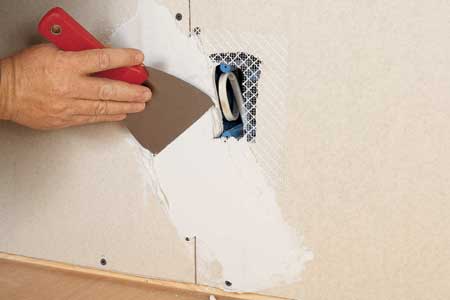How To Patch Drywall
The following pointers are about tips on how to repair scars and paint chips around the home. Small holes caused by screws or hooks, wall fasteners or drywall fasteners that pop up are easy to restore, but once more time consuming because you nearly always have to repaint the partitions. Lower away free joint compound and paper shreds. Place drywall piece over the broken space (image 1) and trace round it with a pencil (picture 2). Use a drywall or reciprocating saw to cut out the world throughout the traced lines (picture three). Reduce two items of 2×4 slightly bigger than the outlet.
Use a drywall saw to cut out the drawn area. Mix a tablespoon or two of water into three or four cups of the joint compound to make it simpler to spread. Next, place the drywall patch over the opening within the wall and trace the shape on the wall with a pencil. (It isn’t needed to reinforce the horizontal edges of the alternative drywall.) Safe the 2x4s to the drywall with drywall screws (picture four). Set the brand new drywall into the opening and secure to the 2x4s with screws.
And you may apply a second coat of compound as soon as the first hardens. Apply self-adhering fiberglass mesh tape over the restore-panel seams. For holes as much as 6 inches, use the California Patch. The drywall screws will draw the boards in tight. Skilled drywall tapers all the time fill a row of screw holes with one long stripe of joint compound, reasonably than filling each screw gap individually.
Apply joint compound to the back of the paper border. Let it dry, then apply more drywall compound, feathering the edges as you go. Like we did for the patches we mentioned earlier, it would take a number of coats, in addition to a light-weight sanding, between each coat. The cost of reaparing drywall is $180. Sand it clean and apply a second coat if crucial. Hold them tight to the backside of the drywall when fastening them.
You possibly can create your own patch to restore larger holes in drywall. Subsequent, use a wide (eight- to 12-inch) joint-compound taping knife to fully cowl the patch with a third and closing coat. Cut a chunk of drywall into a square form that is 2 inches bigger in width and height than the world to be repaired. Taping knife, and sand solely the last coat. Two coats of drywall compound, applied with two swipes of the knife in a +” pattern, ought to fill the holes (Photograph three). The first coat will shrink a bit, leaving a slightly smaller dent to be filled by the second coat.